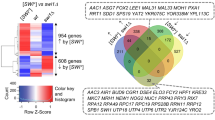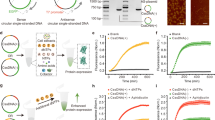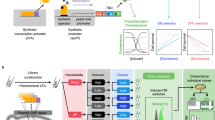Abstract
TRANSCRIPTION of the HO gene of Saccharomyces cerevisiae, which encodes a site-specific endonuclease that initiates cell-type switching (reviewed in refs. 1,2), is restricted to a short window of the cell cycle in late Gl (refs 3,4). A repeated element in the upstream region of HO (the cell-cycle box, CCB) and two regulatory proteins, SWI4 and SWI6, are required for cell-cycle-dependent expression of HO5,6. Biochemical experiments have identified a factor, CCBF (cell-cycle box factor), that binds to the CCB elements7 and that presumably plays a key part in cell-cycle regulation of HO. The SWI4 and SWI6 genes are required for formation of the CCBF-DNA complex. Here we report the nucleotide sequence of the SWI4 gene and show that it contains two copies of the conserved SWI6-cdclO motif observed in SWI6 of budding yeast8, the Schizosaccharomyces pombe cdc10 gene required for progression through G19, the Drosophila Notch gene, and in the Caenorhabditis elegans lin-12 and glp-1 genes10–12. We demonstrate by using antibodies to the SWI4 protein in gel-shift assays that the protein is present in the CCBF–DNA complex.
This is a preview of subscription content, access via your institution
Access options
Subscribe to this journal
Receive 51 print issues and online access
$199.00 per year
only $3.90 per issue
Buy this article
- Purchase on SpringerLink
- Instant access to full article PDF
Prices may be subject to local taxes which are calculated during checkout
Similar content being viewed by others
References
Nasmyth, K. A. & Shore, D. Science 237, 1162–1170 (1987).
Herskowitz, I. Microbiol. Rev. 52, 536–553 (1988).
Jensen, R. E., Sprague, G. F. & Herskowitz, I. Proc. natn Acad Sci. U.S.A. 80, 3035–3039 (1983).
Nasmyth, K. A. Nature 302, 670–676 (1983).
Nasmyth, K. A. Cell 42, 225–235 (1985).
Breeden, L. & Nasmyth, K. A. Cell 48, 389–397 (1987).
Andrews, B. J. & Herskowitz, I. Cell 57, 21–29 (1989).
Breeden, L. & Nasmyth, K. Nature 329, 651–654 (1987).
Aves, S. J., Durkacz, B. W., Carr, A. & Nurse, P. EMBO J. 4, 457–463 (1985).
Wharton, K. A., Johansen, K., Xu, T. & Artavanis-Tsakonas, S. Cell 43, 567–581 (1985).
Yochem, J., Weston, K. & Greenwald, I. Nature 335, 547–550 (1988).
Yochem, J. & Greenwald, I. Cell 58, 887–898 (1989).
Courey, A. J. & Tijan, R. Cell 55, 887–898 (1988).
Stern, M., Jensen, R. & Herskowitz, I. J. molec. Biol 178, 853–868 (1984).
Johnston, L. H., White, J. H. M., Johnson, A. L., Lucchini, G. & Plevani, P. Nucleic Acids Res. 15, 5017–5030 (1987).
Sternberg, P. W., Stern, M., Clark, I. & Herskowitz, I. Cell 48, 567–577 (1987).
Kleid, D., Yamsura, D., Small, B. & Dowbenko, D. Science 214, 1125–1128 (1981).
Towbin, H., Staehelin, T. & Gordon, J. Proc. natn. Acad. Sci. U.S.A. 76, 4350–4354 (1979).
Bender, A. & Sprague, G. F. Cell 50, 681–691 (1987).
Snyder, M. J. cell. Biol. 108, 1419–1429 (1989).
Author information
Authors and Affiliations
Rights and permissions
About this article
Cite this article
Andrews, B., Herskowitz, I. The yeast SWI4 protein contains a motif present in developmental regulators and is part of a complex involved in cell-cycle-dependent transcription. Nature 342, 830–833 (1989). https://doi.org/10.1038/342830a0
Received:
Accepted:
Issue date:
DOI: https://doi.org/10.1038/342830a0
This article is cited by
-
Gcn5 and Rpd3 have a limited role in the regulation of cell cycle transcripts during the G1 and S phases in Saccharomyces cerevisiae
Scientific Reports (2019)
-
A transcriptome-wide analysis deciphers distinct roles of G1 cyclins in temporal organization of the yeast cell cycle
Scientific Reports (2019)
-
Identification of yeast cell cycle regulated genes based on genomic features
BMC Systems Biology (2013)
-
Pathocycles: Ustilago maydis as a model to study the relationships between cell cycle and virulence in pathogenic fungi
Molecular Genetics and Genomics (2006)
-
Exploring the conditional coregulation of yeast gene expression through fuzzy k-means clustering
Genome Biology (2002)



